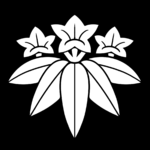
Emperor Go-Murakami was the 97th emperor of Japan, according to the traditional order of succession, and a member of the Southern Court during the Nanboku-chō period of rival courts. He reigned from September 18, 1339, until March 29, 1368. His personal name was Noriyoshi (義良). He reigned from Sumiyoshi, Ōsaka, Yoshino, Nara, and other temporary locations.

Tsukahara Bokuden was a famous swordsman of the early Sengoku period. He was described as a kensei. He was the founder of a new Kashima style of kenjutsu, and served as an instructor of Shōgun Ashikaga Yoshiteru and Ise provincial governor daimyō Kitabatake Tomonori.
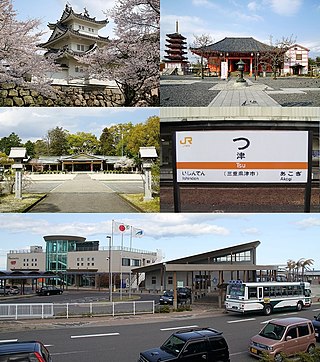
Tsu is the capital city of Mie Prefecture, Japan. As of 31 July 2021, the city had an estimated population of 274,879 in 127,273 households and a population density of 390 persons per km². The total area of the city is 711.11 square kilometres (274.56 sq mi). Although the second largest city in the prefecture in terms of population, its designation as the prefectural capital and its holding of a large concentration of national government offices and educational facilities make the city the administrative and educational center of Mie Prefecture.
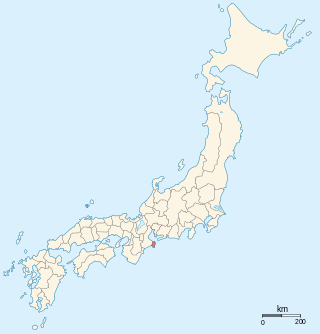
Shima Province was a province of Japan which consisted of a peninsula in the southeastern part of modern Mie Prefecture. Its abbreviated name was Shishū (志州). Shima bordered on Ise Province to the west, and on Ise Bay on the north, east and south. It roughly coincides with the modern municipalities of Shima and Toba.

Hitachi Province was an old province of Japan in the area of Ibaraki Prefecture. It was sometimes called Jōshū (常州). Hitachi Province bordered on Shimōsa, Shimotsuke, and Mutsu Provinces. Generally, its northern border was with Mutsu.

Hōji (宝治) was a Japanese era name after Kangen and before Kenchō. This period spanned the years from February 1247 to March 1249. The reigning emperor was Go-Fukakusa-tennō (後深草天皇,).

Kitabatake Chikafusa was a Japanese court noble and writer of the 14th century who supported the Southern Court in the Nanboku-cho period, serving as advisor to five Emperors. Some of his greatest and most famous work was performed during the reign of Emperor Go-Daigo, under whom he proposed a series of reforms, amounting to a revival or restoration of political and economic systems of several centuries earlier. In addition to authoring a history of Japan and a number of works defending the right of Go-Daigo's line to the throne, Kitabatake fought in defense of the Southern Court as a member of the Murakami branch of the Minamoto clan.

Kitabatake Akiie was a Japanese court noble, and an important supporter of the Southern Court during the Nanboku-chō Wars. He also held the posts of Commander-in-Chief of the Defense of the North, and Governor of Mutsu Province. His father was Imperial advisor Kitabatake Chikafusa.

Oda Nobukatsu was a Japanese samurai of the Azuchi–Momoyama period. He was the second son of Oda Nobunaga. He survived the decline of the Oda clan from political prominence, becoming a daimyō in the early Edo period. Though often described as an incompetent general, Nobukatsu was a skilled warrior. In the battle of Komaki and Nagakute, he used a 13th-century tachi of the Fukuoka Ichimonji school, to slay a samurai known as Okada Sukesaburō, therefore the blade was known as "Okada-giri Yoshifusa", now a national treasure.

The Minister of the Left was a government position in Japan during the Asuka to Meiji era. The Asuka Kiyomihara Code of 689 marks the initial appearance of the Sadaijin in the context of a central administrative body called the Daijō-kan. This early Daijō-kan was composed of the three ministers—the Daijō-daijin, the Sadaijin and the Udaijin. The position was consolidated in the Taihō Code of 702.
Ohama Kagetaka was a Japanese pirate during the latter part of the Sengoku period and the Azuchi–Momoyama period of Japan. He operated in the Shima Province area, and later commanded naval forces for both Takeda Shingen and Tokugawa Ieyasu before his death in 1597 at the age of 57.
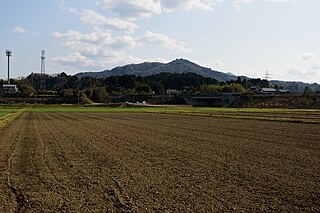
Azaka Castle was a Japanese castle located in what is now the Oazaka neighborhood of the city of Matsusaka, Mie in the Kansai region of Japan. Its ruins were designated a National Historic Site in 1982, collectively with the ruins of Taka Castle and Karatachi Castle. All of these fortifications were important citadels of the Kitabatake clan who controlled northern Ise Province in the Nanboku-chō period.

Tomonori is a masculine Japanese given name.

Kitabatake Shrine is a Shinto shrine located in the Misugi neighborhood of the city of Tsu, Mie Prefecture, Japan. It is one of the Fifteen Shrines of the Kenmu Restoration. The main kami enshrined is the deified spirit of the imperial loyalist Kitabatake Akiyoshi and other members of the Kitabatake clan. The shrine's main festival is held annually on October 13.

Maebashi Domain was a feudal domain under the Tokugawa shogunate of Edo period Japan, located in Kōzuke Province, Japan. It was centered on Maebashi Castle in what is now part of the city of Maebashi, Gunma.

Kitabatake Tomonori was the lord of south Ise Province, who ruled from Kitabatake Shrine in Mie Prefecture. He learned swordsmanship from Tsukahara Bokuden and so was famous as a skilled swordsman. His territory was invaded by Oda Nobunaga in 1569. He surrendered and adopted Nobunaga’s second son Oda Nobukatsu.

Tamaru Castle was a Japanese castle located in Tamaki, northern Mie Prefecture, Japan. At the end of the Edo period, Tamaru Castle was home to the Kuno clan, daimyō of Tamaru Domain and one of the hereditary karō to Kii Domain. The ruins are a Mie Prefecture Historic Site.
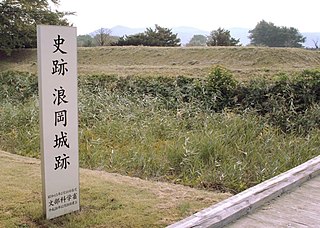
Namioka Castle was a Muromachi period Japanese castle located in what is now the city of Aomori, Aomori Prefecture, in the Tōhoku region of far northern Japan. The ruins were designated a National Historic Site in 1940 by the Japanese government.

Kiriyama Castle was a yamashiro-style Muromachi period Japanese castle located in the Misugi neighborhood the city of Tsu, Mie Prefecture, in the Kansai region of Japan. Its ruins have been protected as a National Historic Site since 1934.. The castle is also known as Tage Castle.
The Anekōji clan was a Japanese samurai family descending from the Fujiwara clan. During the Sengoku period, they served as daimyo of Hida Province. The clan is also known as Anegakōji clan.
